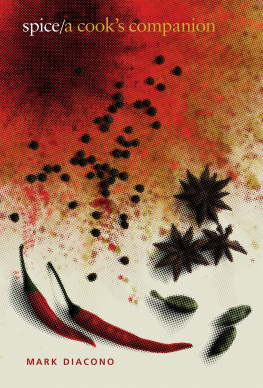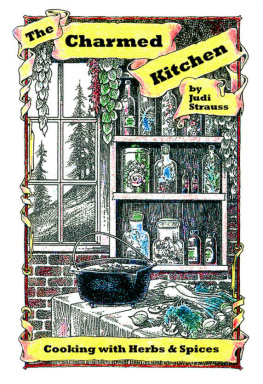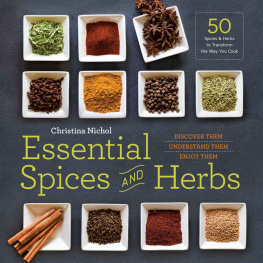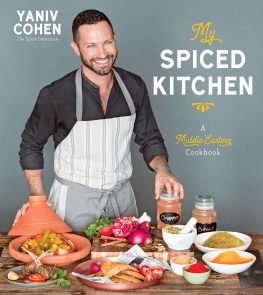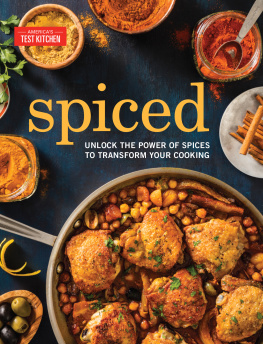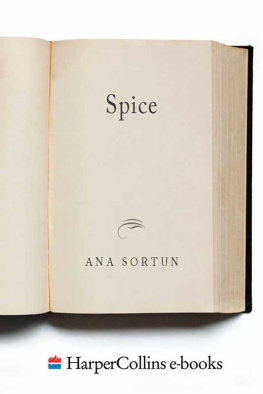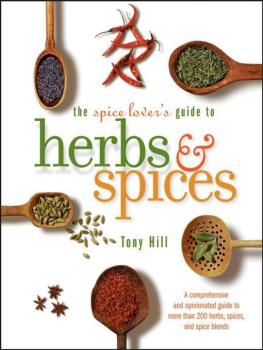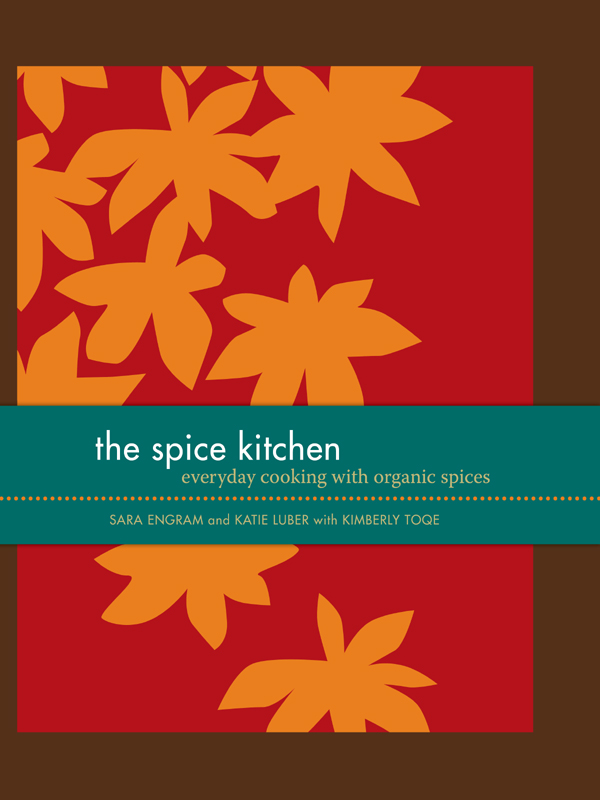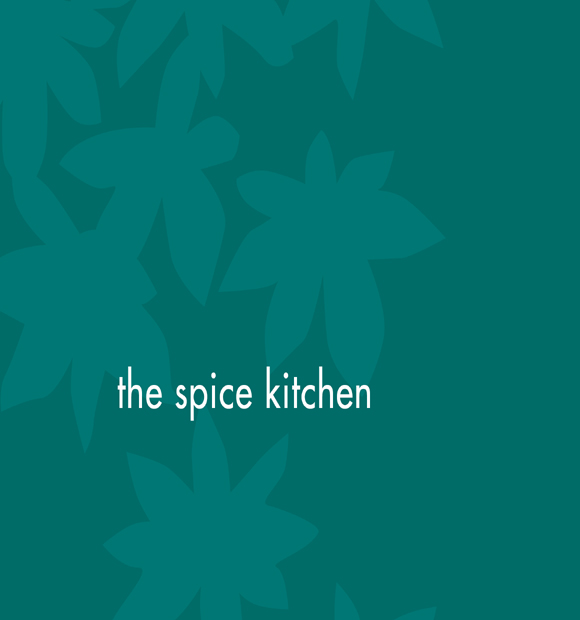

FOR OUR FAMILIES DIANA, JACOB, JOHN HENRY, PHIL, AND JACK WHO MAKE IT ALL WORTHWHILE.
The Spice Kitchen text copyright 2009 by The Seasoned Palate, Inc. Photographs copyright 2009 by David Morris Photography. Illustrations copyright 2009 by Julie Pelaez. All rights reserved. Printed in China. No part of this book may be used or reproduced in any manner whatsoever without written permission except in the case of reprints in the context of reviews. For information, write Andrews McMeel Publishing, LLC, an Andrews McMeel Universal company, 1130 Walnut Street, Kansas City, Missouri 64106.
Library of Congress Cataloging-in-Publication Data
www.andrewsmcmeel.com
Engram, Sara.
The spice kitchen : everyday cooking with organic spices / Sara Engram & Katie Luber with Kimberly Toqe.
p. cm.
Includes bibliographical refrences and index.
E-ISBN: 978-0-7407-9062-1
1. Cookery (Spices) 2. Spices. 3. Cookery (Natural foods) I. Luber, Katie. II. Toqe, Kimberly. III. Title.
TX819.A1E65 2009
641.3383dc22
2009006731
www.tspspices.com
Photography David Morris Photography/www.davidmorrisphoto.com
Food styling by Kimberly Kissling and Tina Bell Stamos
Illustrations by Julie Pelaez
Book design by Julie Barnes
Book composition by Diane Marsh
ATTENTION: SCHOOLS AND BUSINESSES
Andrews McMeel books are available at quantity discounts with bulk purchase for educational, business, or sales promotional use. For information, please write to: Special Sales Department, Andrews McMeel Publishing, LLC, 1130 Walnut Street, Kansas City, Missouri 64106.
Acknowledgments
We have many people to thank for making this book a reality. Kimberly Toqe brought technical skill, imagination, and good humor to the task of pulling together and testing a collection of recipes that reflected our desire to help cooks broaden their use of spices in foods their families already know and love.
Anne Pushkals formidable research skills, nimble writing, and infectious wit resulted in profiles of our favorite spices, herbs, and zests that will surely tempt even spice-shy cooks to expand their culinary horizons.
Many friends and colleagues helped us test and refine these recipes. Our thanks to Nancy Meadows, John Dearing, Stephanie Adler, Rosemary Connolly Gately, Amy Carey, Camille Peluso, Mary Leight, Adele Gammon, Lee Pierce, Edie Meacham, Grace Pollack, Pat Shaw, Jan Schroeder, and Edie Windsor for your suggestions, tests, and comments.
We extend our thanks to Lane Butler, Kirsty Melville, and all the helpful people at Andrews McMeel Publishing. You have been a pleasure to work with.
We are grateful to our families for putting up with all our spice experiments, and especially for their unwavering support as we have pursued our dream of spice enlightenment.

Tarragon and rosemary
Contents
Introduction
People like to change things. We turn dirt into dye, clay into cups, words into poems, and a grab bag of ingredients into meals as varied as a hearty wild-game cassoulet or a simple vegetable curry. This persistent urge to transform raw materials into something useful and appealing sets us apart from other creatures. Why settle for a plain slab of tough meat when you can season it, simmer it, and enjoy a feast?
In the annals of cooking, spices rank as one of our oldest and most reliable tools-right up there with fire and heat. Excavations of Neolithic caves have uncovered traces of cumin and other spices, evidence of an active spice trade reaching back 8,000 to 10,000 yearsand prehistoric grounding for one of our favorite food mantras: eat locally, but season globally. Neolithic humans probably obtained their spices by way of trade routes established overland from India and Sri Lanka into Mesopotamia, the fertile cradle of civilization, located between the Tigris and Euphrates rivers (now largely part of Iraq).
When archaeologists were able to decipher tablets dating back 4,000 years to the Mesopotamian empire of Babylon, they found records of numerous spices, including anise seed, cumin, coriander, mint, juniper, cardamom, fenugreek, mustard seed, and asafetida. Excavations of 4,000-year-old Mesopotamian archaeological sites have uncovered cloves far from their home in Indonesia.
The Babylonians even had recipe tablets with descriptions of more than 100 different varieties of soups and stews. In these recipes, meats were always braised in water with some form of fat and combinations of up to four spicesnot so different from our fusion cooking of today.
The ancient Egyptians were spice lovers, too, cooking with cumin, anise, coriander, fenugreek, black mustard seed, fennel, dill, mint, marjoram, sage, and thyme. Spices also played a role in their elaborate death rituals. They were used in the mummification process, and the departed were always provided with a good supply of spices to accompany them into the afterlife. The Egyptians celebrated spices in life as well. On numerous occasions, the great pharaoh Ramses II presented cinnamon to the gods.
a word about organic spices
Some people believe organic certification for spices is less important than for other foods. We disagree. Spices, herbs, and zests provide concentrated flavors. When you taste a teaspoon of pure cinnamon or cumin or tarragonwith no fillers or additives or other substancesyou get pure flavor, a real bang for your buck.
But because most spices are packaged in jars or bottles designed to hold as much as cup, they often need anti-caking agents or other additives. That dilutes the flavor, if only by a little bit. Moreover, regulations on herbs and spices are relatively loose, and those bargainslike that huge container of basil for a couple of dollars Sara kept in her cabinet for a decadeare likely to have a substantial amount of filler. Organic spices must be pure, not diluted by fillers or additives.
Moreover, organic certification provides assurance that these ingredients do not contain pesticides. Organic certification is particularly important for zests, since pesticides used in growing nonorganic citrus fruits tend to lodge in the peel, providing an extra dose of toxins in nonorganic orange or lemon zest.
Around the world, spice growers and suppliers are recognizing that there is value in an organic designation. It tells consumers they get full value for their spice investment. Equally important, it creates working conditions that protect the health of workers and their families and encourages agricultural practices that sustain the environment in which spices and herbs grow best.
We think spices and herbs are among Natures most magical gifts, gifts that we should treasure and relish. Thats why we believe organic is important.
The Greeks and Romans followed suit, embracing a range of spices and herbs, including coriander (a favorite), cumin, cardamom, peppergrass, cress, saffron, and ginger grass. Cinnamon was a rare and beloved luxuryso costly that the Greek historian Herodotus suggested that it was secretly harvested from the nests of huge, dangerous birds in the mountains of Ethiopia.


